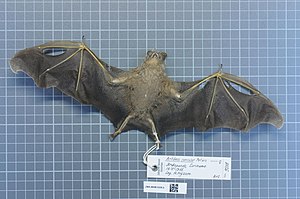Brown fruit vampire
| Brown fruit vampire | ||||||||||||
|---|---|---|---|---|---|---|---|---|---|---|---|---|

Brown fruit vampire ( Artibeus concolor ) |
||||||||||||
| Systematics | ||||||||||||
|
||||||||||||
| Scientific name | ||||||||||||
| Artibeus concolor | ||||||||||||
| Peters , 1865 |
The brown fruit vampire ( Artibeus concolor ) is a species of bat from the family of leaf noses (Phyllostomidae), which is native to the Amazon basin . It used to be assigned to the monotypical genus Koopmania as Koopmania concolor .
description
The brown fruit vampire is a medium-sized bat with an average weight of 18.3 g in males and 20 g in females (sexual dimorphism ). In contrast to many other representatives of the actual fruit vampires , it has no facial stripes. The coat is long (8-10 mm) and silky, dark brown on the back and lighter on the head and shoulders. The hair is gray at the base, yellowish in the middle, and brown at the tips. The ears, nostrils and flight membrane are black. Compared to other types of actual fruit vampires, the brown fruit vampire has a relatively large nosepiece .
Way of life
Little is known about the way of life. The brown fruit vampire is a fruit eater, however, like other actual fruit vampires, it also consumes pollen, nectar, flower parts and insects. Other studies show that the brown fruit vampire may also eat leaves. It occurs in humid areas at an altitude of up to 1000 meters above sea level. A single pregnant female was caught in Colombia in February.
distribution and habitat
The brown fruit vampire is common in the Amazon basin from southern Colombia to northern Brazil . Thanks to its widespread use, the IUCN classifies its population as safe.
Systematics
The species was originally described as a species of the genus Artibeus , but subsequently mostly placed in its own monotypical genus as Koopmania concolor . However, a new study shows that without the inclusion of Koopmania, the genus Artibeus would be paraphyletic . Koopmania is therefore placed as the third subgenus to Artibeus .
literature
- CE Acosta, RD Owen: Koopmania concolor , Mammalian Species , No. 429 (1993): pp. 1-3.
swell
- ↑ B. Enrico (1997): Folivory in Artibeus concolor (Chiroptera: Phyllostomidae): a new evidence. Chiroptera Neotropical 3: pp. 77-79.
- ^ Artibeus concolor in the IUCN Red List of Threatened Species .
- ^ RAF Redondo, LPS Brina, RF Silvaa, AD Ditchfield, FR Santos (2008): Molecular systematics of the genus Artibeus (Chiroptera: Phyllostomidae). Molecular Phylogenetics and Evolution 49: 44-58. - doi : 10.1016 / j.ympev.2008.07.001
